Ich erinnere mich noch gut an die Frustration, als ich einen meiner ersten Blogbeiträge auf Facebook teilte und nur ein völlig zufälliges, verpixeltes Bild angezeigt wurde. Nachdem ich Stunden in den Inhalt investiert hatte, war es entmutigend zu sehen, wie er falsch dargestellt wurde, bevor überhaupt jemand die Chance hatte, darauf zu klicken.
Das passiert, wenn eine Website Social-Media-Plattformen keine klaren Anweisungen gibt, was angezeigt werden soll. Ohne diese Anleitung muss Facebook raten, und es rät oft falsch.
Hier bei WPBeginner haben wir gemeistert, wie wir unser Social-Sharing-Erscheinungsbild mit Open-Graph-Metadaten steuern. In diesem Leitfaden führen wir Sie durch die bewährten Methoden, die wir verwenden, damit Ihre Inhalte immer bestmöglich aussehen, wenn sie geteilt werden.

Sie können die untenstehenden Schnelllinks verwenden, um direkt zu der Methode zu springen, die Sie am meisten interessiert:
- Hinzufügen von Facebook Open Graph Metadaten mit AIOSEO
- Facebook Open Graph-Metadaten mit Yoast SEO festlegen
- Hinzufügen von Facebook Open Graph Metadaten mit Code
- Häufig gestellte Fragen zu Facebook Open Graph
- Zusätzliche Ressourcen zu Facebook und WordPress
Wichtig: Bitte wählen Sie nur eine der folgenden Methoden. Die Verwendung mehrerer SEO-Plugins oder das manuelle Hinzufügen von Code, während ein Plugin aktiv ist, kann zu widersprüchlichen Open-Graph-Tags führen, was zu unerwarteten Sharing-Ergebnissen führen kann. Wir empfehlen Methode 1 mit AIOSEO für die einfachste und umfassendste Einrichtung.
Methode 1: Hinzufügen von Facebook Open Graph-Metadaten mit AIOSEO
All in One SEO ist ein beliebtes WordPress SEO-Plugin, das von über 3 Millionen Websites genutzt wird. Es ermöglicht Ihnen, Ihre Website einfach für Suchmaschinen sowie soziale Plattformen wie Facebook und Twitter zu optimieren.
Zuerst müssen Sie das kostenlose All in One SEO-Plugin installieren und aktivieren. Weitere Details finden Sie in unserer Schritt-für-Schritt-Anleitung zur Installation eines WordPress-Plugins.
Upon activation, you need to visit the All in One SEO » Social Networks page. Here, you can enter your Facebook page URL and all your other social networks.
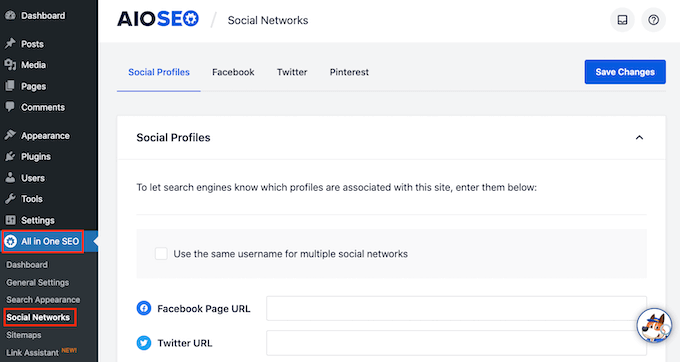
Klicken Sie als Nächstes auf den Facebook-Tab oben auf der Seite, und Sie sehen, dass Open Graph Markup standardmäßig aktiviert ist.
Sie können auf die Schaltfläche 'Bild hochladen oder auswählen' klicken, um ein Standard-Facebook-OG-Bild auszuwählen, wenn ein Artikel kein Open-Graph-Bild hat.
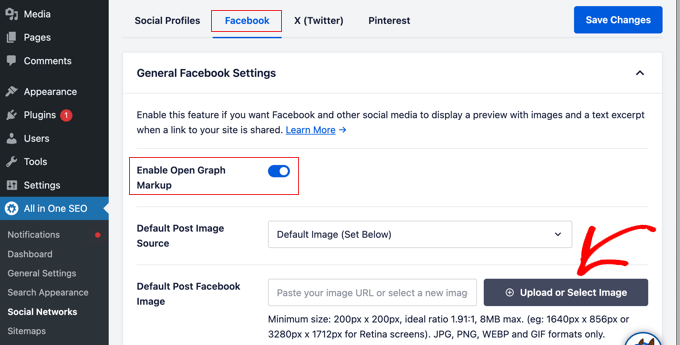
Wenn Sie nach unten scrollen, können Sie den Namen Ihrer Website, die Beschreibung und weitere Einstellungen anpassen. Vergessen Sie nicht, auf die blaue Schaltfläche „Änderungen speichern“ zu klicken, sobald Sie fertig sind.
Nachdem Sie nun Website-weite Open Graph Metatags festgelegt haben, besteht der nächste Schritt darin, Open Graph Metadaten für einzelne Beiträge und Seiten hinzuzufügen.
Standardmäßig verwendet AIOSEO den SEO-Titel und die Meta-Beschreibung Ihres Beitrags für den Open-Graph-Titel und die Beschreibung. Sie können auch manuell das Facebook-Thumbnail für jede Seite und jeden Beitrag festlegen.
Bearbeiten Sie einfach den Beitrag oder die Seite und scrollen Sie nach unten zum Abschnitt „AIOSEO-Einstellungen“ unterhalb des Editors. Wechseln Sie von hier aus zur Registerkarte „Soziales“, und Sie sehen eine Vorschau Ihres Thumbnails.
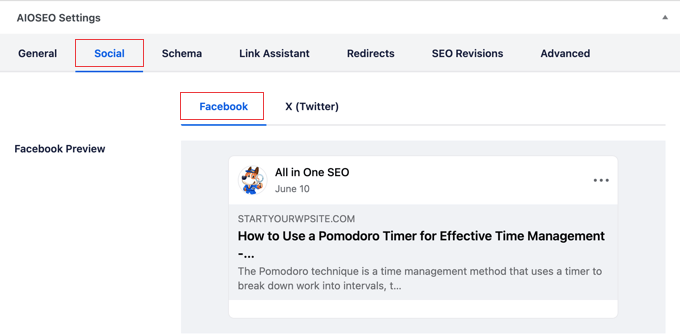
Hier können Sie das Social-Media-Bild sowie den Titel und die Beschreibung festlegen.
Scrollen Sie einfach nach unten zum Feld „Bildquelle“. Sie können das Beitragsbild verwenden, ein benutzerdefiniertes Bild hochladen oder andere Optionen wählen.
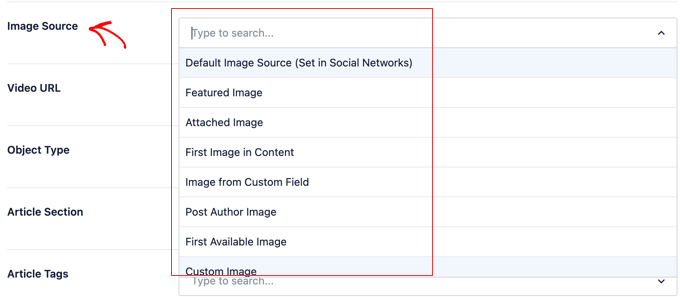
Methode 2: Facebook Open Graph-Metadaten mit Yoast SEO festlegen
Yoast SEO ist ein weiteres WordPress SEO Plugin, das Sie verwenden können, um Facebook Open Graph Metadaten zu jeder WordPress-Website hinzuzufügen.
Das Erste, was Sie tun müssen, ist das Yoast SEO Plugin zu installieren und zu aktivieren. Weitere Details finden Sie in unserer Schritt-für-Schritt-Anleitung zur Installation eines WordPress-Plugins.
Nach der Aktivierung sind die Facebook Open Graph-Daten standardmäßig aktiviert.
Sie können dies überprüfen, indem Sie zu Yoast SEO » Einstellungen gehen und zum Abschnitt Social Sharing scrollen. Stellen Sie nun sicher, dass die Funktion für Open Graph-Daten aktiviert ist.
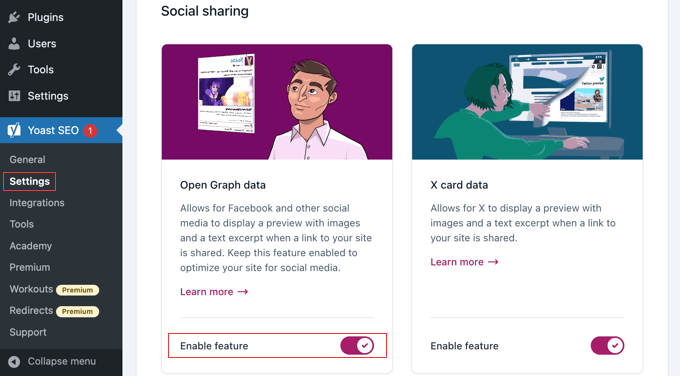
Sie können Ihre Einstellungen speichern oder fortfahren und andere Facebook-Social-Optionen konfigurieren.
Sie können eine Facebook-App-ID angeben, wenn Sie eine für Ihre Facebook-Seite und Einblicke verwenden. Sie können auch den Open Graph-Meta-Titel, die Beschreibung und das Bild Ihrer Homepage ändern.
Schließlich können Sie ein Standardbild festlegen, das verwendet wird, wenn für einen Beitrag oder eine Seite kein Bild festgelegt ist.
Die Premium-Version von Yoast SEO ermöglicht es Ihnen auch, Open Graph-Metadaten für einzelne Beiträge und Seiten festzulegen. Bearbeiten Sie einfach einen Beitrag oder eine Seite und scrollen Sie nach unten zum Abschnitt „Yoast SEO“ unterhalb des Editors.
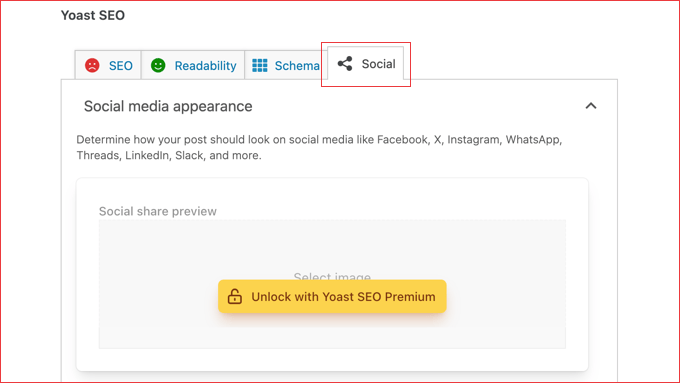
Von hier aus können Sie ein Facebook-Thumbnail für diesen speziellen Beitrag oder diese Seite festlegen. Wenn Sie keinen Beitragstitel oder keine Beschreibung festlegen, verwendet das Plugin Ihren SEO-Meta-Titel und Ihre Meta-Beschreibung.
Sie können Ihren Beitrag oder Ihre Seite jetzt speichern, und das Plugin speichert Ihre Facebook Open Graph-Metadaten.
Methode 3: Hinzufügen von Facebook Open Graph-Metadaten per Code
Diese Methode erfordert normalerweise, dass Sie Code in die Datei functions.php Ihres Themes kopieren und einfügen. Wir empfehlen jedoch, den Code stattdessen mit dem WPCode-Plugin hinzuzufügen, was das Hinzufügen von benutzerdefiniertem Code in WordPress einfacher und sicherer macht.
WPCode enthält auch eine Bibliothek mit fertigen Code-Snippets, darunter eines zum Hinzufügen grundlegender Open-Graph-Tags, sodass es nur wenige Klicks erfordert.
Installieren und aktivieren Sie zuerst das kostenlose WPCode-Plugin. Weitere Details finden Sie in unserem Leitfaden zur Installation eines WordPress-Plugins.
Nach der Aktivierung können Sie in Ihrem WordPress-Dashboard zu Code Snippets » + Snippet hinzufügen navigieren.
Suchen Sie im Bibliotheksbereich nach dem Snippet „Add basic Open Graph Tags“. Sobald Sie es gefunden haben, fahren Sie mit der Maus darüber und klicken Sie auf die Schaltfläche „Snippet verwenden“.

Dann fügt WPCode den Code automatisch für Sie hinzu und legt die Website-weite Kopfzeile als Einfügungsmethode fest.
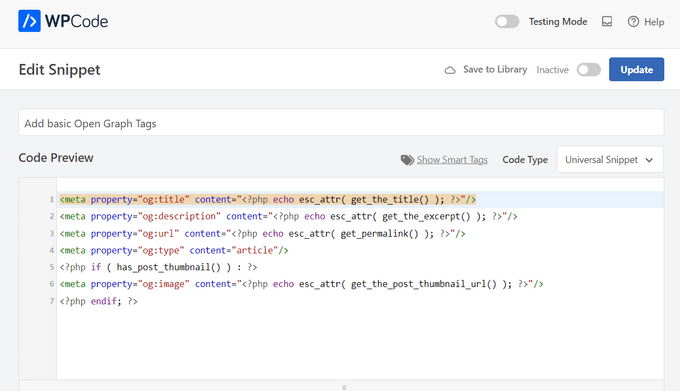
Danach müssen Sie nur noch den Snippet auf „Aktiv“ umschalten und auf die Schaltfläche „Aktualisieren“ klicken. Ihr Theme zeigt nun Facebook Open Graph Metadaten im WordPress-Header an.

Wenn Sie ein fortgeschrittener Benutzer sind, können Sie den folgenden Code immer noch kopieren und in die functions.php-Datei Ihres Themes einfügen.
Da dies erfordert, dass Sie Ihre Theme-Dateien direkt bearbeiten, stellen Sie sicher, dass Sie eine Sicherung Ihrer Theme-Dateien erstellen, bevor Sie Änderungen vornehmen.
//Adding the Open Graph in the Language Attributes
function add_opengraph_doctype( $output ) {
return $output . ' xmlns:og="http://opengraphprotocol.org/schema/" xmlns:fb="http://www.facebook.com/2008/fbml"';
}
add_filter('language_attributes', 'add_opengraph_doctype');
//Lets add Open Graph Meta Info
function insert_fb_in_head() {
global $post;
if ( !is_singular()) //if it is not a post or a page
return;
echo '<meta property="fb:app_id" content="Your Facebook App ID" />';
echo '<meta property="og:title" content="' . get_the_title() . '"/>';
echo '<meta property="og:type" content="article"/>';
echo '<meta property="og:url" content="' . get_permalink() . '"/>';
echo '<meta property="og:site_name" content="Your Site Name Goes Here"/>';
if(!has_post_thumbnail( $post->ID )) { //the post does not have featured image, use a default image
$default_image="http://example.com/image.jpg"; //replace this with a default image on your server or an image in your media library
echo '<meta property="og:image" content="' . $default_image . '"/>';
}
else{
$thumbnail_src = wp_get_attachment_image_src( get_post_thumbnail_id( $post->ID ), 'medium' );
echo '<meta property="og:image" content="' . esc_attr( $thumbnail_src[0] ) . '"/>';
}
echo "
";
}
add_action( 'wp_head', 'insert_fb_in_head', 5 );
Denken Sie daran, Ihren Seitennamen in Zeile 17 hinzuzufügen, wo 'Ihr Seitennamen hier' steht. Danach sollten Sie die Standard-Bild-URL in Zeile 19 mit einer Ihrer eigenen Bild-URLs ändern.
Wir empfehlen, dort ein Bild mit Ihrem Logo zu platzieren, sodass, wenn Ihr Beitrag kein Vorschaubild hat, das Logo Ihrer Website verwendet wird.
Sie müssen auch Ihre eigene Facebook App ID in Zeile 13 hinzufügen. Wenn Sie keine Facebook-App haben, können Sie Zeile 13 aus dem Code entfernen.
Häufig gestellte Fragen zu Facebook Open Graph
Wir haben Tausenden von Benutzern geholfen, ihre Social-Sharing-Einstellungen einzurichten, und einige Fragen tauchen recht häufig auf. Hier sind die Antworten auf die häufigsten Fragen zum Hinzufügen von Facebook Open-Graph-Metadaten.
1. Wie teste ich, ob meine Open-Graph-Tags korrekt funktionieren?
Der beste Weg, Ihre Tags zu überprüfen, ist das offizielle Sharing Debugger-Tool von Facebook. Geben Sie einfach die URL Ihres Beitrags oder Ihrer Seite ein, und das Tool zeigt Ihnen eine Vorschau, wie er beim Teilen aussehen wird, und listet alle gefundenen Fehler oder Warnungen auf.
2. Was ist die beste Bildgröße für ein Facebook Open Graph-Bild?
Für die besten Ergebnisse auf hochauflösenden Displays empfiehlt Facebook die Verwendung von Bildern mit einer Mindestgröße von 1200 x 630 Pixeln. Es ist wichtig, ein Seitenverhältnis von 1,91:1 beizubehalten, um zu verhindern, dass Ihr Bild unschön beschnitten wird.
3. Warum zeigt Facebook ein falsches Bild an, auch nachdem ich eines festgelegt habe?
Dies ist normalerweise ein Caching-Problem. Facebook speichert die Open Graph-Daten, die es zuerst für eine URL sieht. Wenn Sie das Bild aktualisieren, müssen Sie Facebook mitteilen, dass es erneut überprüft werden soll, indem Sie die URL durch das Sharing Debugger-Tool laufen lassen und auf die Schaltfläche „Erneut parsen“ klicken.
4. Beeinflussen Open Graph-Tags die SEO meiner Website?
Während Open Graph-Tags Ihre Suchmaschinenrankings nicht direkt beeinflussen, haben sie einen starken indirekten Effekt. Ein überzeugender und professionell aussehender Social-Share führt zu höheren Klickraten und mehr Traffic, was positive Signale für Suchmaschinen sind.
Zusätzliche Ressourcen zu Facebook und WordPress
Wir hoffen, dieser Artikel hat Ihnen geholfen, Facebook Open Graph-Metadaten in WordPress hinzuzufügen. Möglicherweise möchten Sie auch einige andere Anleitungen dazu lesen, wie Sie Facebook in WordPress verwenden können:
- Beste Facebook-Tipps und Tutorials für WordPress-Benutzer
- Wie man automatisch von WordPress nach Facebook postet
- So installieren und richten Sie Facebook-Kommentare in WordPress ein
- So erstellen Sie einen benutzerdefinierten Facebook-Feed in WordPress
- So zeigen Sie Ihre Facebook-Seitenbewertungen in WordPress an
- So beheben Sie das Problem mit falschen Facebook-Thumbnails in WordPress
- So zeigen Sie den Twitter- und Facebook-Account des Autors auf der Profilseite an
- So erstellen Sie eine Facebook-Anzeigen-Landingpage in WordPress
- How to Fix the Facebook and Instagram oEmbed Issue in WordPress
Wenn Ihnen dieser Artikel gefallen hat, abonnieren Sie bitte unseren YouTube-Kanal für WordPress-Video-Tutorials. Sie finden uns auch auf Twitter und Facebook.





WPBeginner-Mitarbeiter
Haben Sie ein Beitragsbild festgelegt? Haben Sie die Standard-Bild-URL im Code durch Ihre eigene Bild-URL ersetzt?
Ikix
Hallo, ich habe alles versucht, was ich konnte, und ich kann kein Miniaturbild anzeigen, wenn ich meine Blog-URL auf Facebook poste. Ich habe den Code wie gesagt hinzugefügt, ich habe Tonnen von Plugins heruntergeladen und es gibt kein Bild auf Facebook! Können Sie mir bitte helfen? Bitte!
Jason C.
Was ist mit nur einem Bild, das den Miniaturansicht-Optionen in Facebook hinzugefügt werden soll? Mir ist aufgefallen, dass es mein Beitragsbild problemlos übernimmt, aber die anderen im Beitrag nicht. Gibt es eine Möglichkeit, sie manuell mit etwas schnellem Code hinzuzufügen?
WPBeginner-Mitarbeiter
Entschuldigung, das Plugin ist nicht mehr verfügbar. Wir haben den Artikel mit neuen Informationen aktualisiert. Wir hoffen, dass Ihnen dies hilft, Facebook Open Graph Meta Data in Ihr WordPress-Website einzufügen.
adepush
Hallo, ist Ihr Plugin noch auf WordPress.org verfügbar?
http://wordpress.org/plugins/facebook-open-graph-meta-in-wordpress/
a.
M
Es zieht immer noch das Bild aus der Seitenleiste anstelle des Bildes, das ich in die Funktionen-Datei eingefügt habe?
damian
Was ist mit og:description?
Musadiq
Hallo,
Wie kann ich ein Facebook in den obigen Code einfügen? Damit es direkt einen Artikel auf unserer Profil-Timeline und auch auf unserer Facebook-Seite veröffentlichen kann. Vielen Dank
Hassan
Es funktioniert bei mir nicht, wenn ich meine Beiträge auf Facebook teile, es werden nur meine letzten Instagram-Bilder angezeigt
Loes Liemburg
Hallo, ich habe dieses Plugin installiert, kann aber die OG-Optionen nicht in meinem Einstellungsmenü sehen. Ich habe aktualisiert und gewartet, aber immer noch nichts. Was ist schief gelaufen?
Manuel Gomez
Bedeutet diese Zeile, dass das Bild die mittlere Größe verwendet?
$thumbnail_src = wp_get_attachment_image_src( get_post_thumbnail_id( $post->ID ), ‘medium’ );
Wenn ich für „big“ ersetze, wird dann das große Bild verwendet? Ich würde gerne den Link-Post im neuen Format auf Facebook sehen, weil ich mehr Klicks bekommen kann.
Danke!
Alexandra
Danke! Der Code hat perfekt funktioniert!
M
Leider hat das bei mir nicht funktioniert, ich kann nicht einmal sehen, dass es im Quellcode des WP-Headers ausgegeben wird. Ich benutze die Code-Methode, da ich keine Plugins auf der Website hinzufügen möchte.
Ich habe die htaccess-Datei überprüft und sie verursacht keine Probleme, da sie bis auf die Permalink-Deklaration leer ist.
Es ist auch kein Caching-Plugin, da ich keines installiert habe. Hat jemand Ideen?
M
Eigentlich tut es mir leid, aber das hat funktioniert, aber leider scheint es mit dem Debugger-Tool immer noch so zu sein, dass das Posten eines Links auf meiner Timeline immer noch nicht das og:image anzeigt.
Selbst wenn es im JSON vorhanden ist. Es ist wirklich bizarr. Der Debugger zeigt den Beitrag, aber ohne Bild in der Share-Vorschau. Hat jemand Ideen?
Attila
Hallo Syed,
Ich habe viele Plugins verwendet, um meine Graph-Metadaten zu extrahieren, seit ich mit WordPress und Facebook begonnen habe, und ich kann sagen, dass "Facebook Open Graph Meta for WordPress" bisher das einfachste und professionellste Plugin ist.
Ich habe jedoch ein kleines Problem… wenn ich meine Beitragslinks mit dem Facebook-Debugger debugge, werden meine Rohdaten des Open Graph-Dokuments nicht richtig angezeigt. Ich habe Sonderzeichen enthalten, da mein Inhalt auf Ungarisch ist.
Hier ist ein Beispiel:
Meta-Tag:
Ich wäre dankbar, wenn mir jemand sagen könnte, wie ich das beheben kann.
Danke im Voraus und weiter so mit der guten Arbeit.
Mit freundlichen Grüßen
JessDelAngel
HI!
Haben Sie eine Lösung dafür gefunden?
Mit freundlichen Grüßen
Jim
Funktioniert gut – danke. Das ist immer noch der beste Weg, um ohne Plugin zu integrieren, oder?
Redaktion
Wir verwenden das Plugin WordPress SEO von Yoast, um dies zu tun.
Admin
Ally
Ich benutze diesen Code schon lange, aber in letzter Zeit gab es Probleme, er zieht nicht immer das Bild. Ich habe den Linter benutzt und diesen Fehler gefunden:
Abgeleitete Eigenschaft Die Eigenschaft 'og:description' sollte explizit angegeben werden, auch wenn ein Wert aus anderen Tags abgeleitet werden kann.
Also habe ich das Beschreibungs-Tag hinzugefügt und das scheint das Bildproblem gelöst zu haben, aber jetzt wird der Artikelinhalt nicht mehr angezeigt.
Hat jemand eine Idee, wie man das lösen kann? Ich muss nur die ersten paar Zeilen des Inhalts anzeigen.
Danke
Redaktion
Verwenden Sie einfach das Yoast's SEO-Plugin, und es hat dies integriert.
Admin
Goob
Yoast's SEO Plugin scheint keine einzelnen Seiten-og:descriptions integriert zu haben.
Redaktion
Ja, es hat es eingebaut. Standardmäßig zieht es Ihre Meta-Beschreibung, aber es gibt auch die Option, die Beschreibung aus dem Yoast SEO Meta-Feld zu ändern.
Theo
Hallo,
Ich habe mich nur gefragt, ob es möglich ist, für einen Beitrag und eine Seite einen anderen „og:type“ zu haben. So wie es jetzt ist (zumindest soweit ich das verstehe) wird für alles in WordPress „og:type“ auf article gesetzt.
Was ist, wenn ich den „og:type“ einer Seite auf „website“ und für einen Beitrag auf „article“ setzen möchte?
Any suggestions or help much appreciated
Danke
Redaktion
Das können Sie mit bedingten Anweisungen mit Sicherheit tun.
Admin
Redaktion
Sie müssen das Beitragsbild mit der Funktion „Beitragsbild“ verknüpfen.
Admin
seitanist
Kann mir jemand erklären, warum
global $post;
benötigt wird und wo es im generierten Code steht?
wpbeginner
@seitanist Ja, der Grund, warum global $post hinzugefügt wird, ist, dass dieser Code außerhalb der Schleife im Abschnitt der Seite hinzugefügt wird. Um die richtigen Informationen abzurufen, müssen wir global $post aufrufen, damit all diese Tags funktionieren.
seitanist
Das hat super funktioniert! Danke!!!
Redaktion
Sie können versuchen, die Social-Funktion im Yoast-Plugin zu deaktivieren und das Simple Facebook Connect-Plugin von Otto herunterzuladen. Aktivieren Sie es einfach und die Basis kümmert sich darum.
Admin
Cno
Hallo, alles hat funktioniert! Wenn ich den Link meines spezifischen Blogbeitrags auf meine Facebook-Pinnwand stelle, habe ich die richtige Miniaturansicht, Beschreibung und den richtigen Seitennamen. Aber der Beitrag auf Facebook zeigt auch automatisch die vollständige URL meiner Website an (direkt unter dem Blogtitel). Stattdessen möchte ich, dass die Permalink des spezifischen Blogbeitrags angezeigt wird – nicht die URL meiner Website. Auf diese Weise kann ich die „Likes“ für diesen bestimmten Beitrag in WordPress integrieren. Bitte! Jemand?
StephanePerez
Hallo, ich habe versucht, das Plugin zu installieren, kann es aber wegen eines fatalen Fehlers nicht aktivieren: Cannot redeclare add_opengraph_doctype()…/fbogmeta.php in Zeile 24
Was soll ich tun?
Danke!
techhogger
Hallo, ich habe diesen Code wie angewiesen auf meinem Blog techhogger.com eingefügt, aber das Problem scheint immer noch nicht gelöst zu sein. Ich kann meine AdSense-Codes im Beschreibungsbereich sehen. Bitte helfen Sie.
waqaslone
@techhogger dasselbe Problem mit… lass es mich wissen, wenn du eine Lösung findest.
wpbeginner
@waqaslone@techhogger Damit die Beschreibung angezeigt wird, müssen Sie die Auszüge verwenden. Alternativ können Sie Ottos Simple Facebook Connect Plugin verwenden und einfach die Basis einschalten. Das würde alles für Sie erledigen.
techhogger
@wpbeginner@waqaslone@techhogger
Ich habe alles gemacht. Habe sogar das von Ihnen genannte Plugin ausprobiert. Versuchen Sie einfach, einen Beitrag von meinem Blog zu teilen, und Sie werden wissen, was genau passiert. Bis zu einem gewissen Grad konnte ich Codes, die im Beschreibungsbereich erscheinen, entfernen. Aber jetzt sehe ich beim Teilen auf FB keine Beschreibungen und Thumbnails des Beitrags. Ich wäre dankbar, wenn Sie mir helfen könnten.
wpbeginner
@techhogger@waqaslone Wir verwenden die hier auf dieser Seite beschriebene Methode auf unserer eigenen Website. Alles funktioniert. Wir verwenden SFC auf List25 und es funktioniert einwandfrei. Ich bin mir nicht sicher, warum Sie diese Probleme haben. SFC hat eine sehr clevere Methode, Ihren Inhalt zu parsen und die Beschreibung zu extrahieren. Ich weiß also mit Sicherheit, dass es die Beschreibung extrahiert. Es extrahiert auch alle Bilder. Das bedeutet höchstwahrscheinlich, dass ein anderes Plugin auf Ihrer Website stört. Haben Sie ein WP-Plugin, um die Like-Box oder den Like-Button hinzuzufügen? Oder irgendein anderes FB-Plugin?
techhogger
@wpbeginner@waqaslone Ich habe versucht, nach Ihrer letzten Antwort erneut zu teilen. Und das Gleiche passiert. Ich sehe nur den Beitragstitel mit der Beschreibung als Beschreibung meines Blogs anstelle der Beitragsbeschreibung und kein Vorschaubild. Ich benutze das Digg Digg Plugin für Social Sharing.
wpbeginner
@techhogger@waqaslone Bitte aktivieren Sie Ottos Simple Facebook Connect Plugin. Entfernen Sie den Code, den Sie in Ihrer functions.php hinzugefügt haben…
techhogger
@wpbeginner@waqaslone Ich glaube, es funktioniert jetzt. Ich habe das Plugin erneut heruntergeladen und konfiguriert. Und jetzt scheint es zu funktionieren. Können Sie es sich ansehen und mir mitteilen, ob jetzt alles in Ordnung ist.
ChristopherJosephDowney
Ich bin es gewohnt, Meta-Tags in den HTML-Code von Blogger einzufügen. Der Wechsel zu Wordpress war in dieser Hinsicht ein Albtraum, da ich kein HTML bearbeiten kann und CSS nicht gewohnt bin. Dieses Plugin ist ein Traum, aber es scheint nicht richtig zu funktionieren. Meine Frage ist folgende: Es scheint, dass ich 3 verschiedene IDs habe: Mein Facebook-Profil, meine Facebook-Fanpage (die, auf die mein Blog verlinkt) und meine OG-Debugger-ID, die auf der Entwickler-Debugger-Seite angezeigt wird; welche ID muss ich für das Plugin verwenden? Egal welche ich in das Plugin eingebe, wenn ich auf „Debug“ klicke, wird das Thumbnail nicht aktualisiert und ist immer eines der animierten GIFs der Werbung. Kann ich mehr als ein Standard-Thumbnail haben, wie ich es mit Megatags in HTML tun würde?
RobKara
Wenn ein Benutzer meine WordPress-Seite „Objekt“ aufruft, wie bekomme ich dann die Facebook-Benutzer-ID, wenn es ein Facebook-Benutzer ist, der die Seite ansieht? Sendet Facebook einen signed_request oder eine Facebook-Benutzer-ID über die Query-String?
wpbeginner
@RobKara Diese Frage sollte im Open Graph Forum gestellt werden, da sie außerhalb des Rahmens dieses Artikels liegt.
MetalPhil
Also habe ich diesen Kram auf meiner Website (AngryMetalGuy.com) installiert und es funktioniert nicht. Ich habe *keine* Ahnung warum. Ich bin jenseits frustriert und super verwirrt. Wenn du mir bitte, bitte, bitte, bitte, bitte helfen könntest, wäre das großartig.
MetalPhil
Übrigens: Ich habe es vor langer Zeit installiert und es funktioniert immer noch nicht. Ich habe dieses Problem seit über einem Monat. Es macht mich fertig.
lizbizz
Ich habe das Facebook OG Meta Plugin auf meinem Blog deaktiviert und stattdessen das Simple Facebook Connect Plugin installiert und jetzt scheint alles auf meiner Website und meinen Beiträgen richtig zu funktionieren!
WPbeginners. com Anleitungen und Informationen (achten Sie darauf, sie genau zu befolgen) mit diesem Beitrag: https://www.wpbeginner.com/plugins/how-to-install-and-setup-simple-facebook-connect-for-wordpress/
lizbizz
Das hat mein Problem mit dem Teilen-Button für Facebook gelöst, aber jetzt, wenn ich versuche, einen Beitrag von meiner Website mit Hootsuite’s Hootlet auf Facebook zu teilen, ist das Beschreibungsfeld leer. Es zeigt das richtige Vorschaubild und die URL, aber keinen Vorschautext des Artikels. Es hat vorher funktioniert und funktioniert für andere Websites immer noch, daher glaube ich, dass es passiert ist, als ich das Plugin installiert habe… Hilfe?
SaijoGeorge
@wpbeginner Facepalm … Thanks for the quick replay mate
wpbeginner
@SaijoGeorge Es wird nur der von Ihrem Beitrag definierte Auszug ausgegeben. Wenn Sie keinen Auszug angeben, wird nichts angezeigt.
SaijoGeorge
Great plugin .. the only issue I seem to be having is that the meta property=”og:description” spits out some random data . Thr url for a sample post is 1800pocketpc.com/watch-out-for-windows-phone-7/22453/ similar issue on another blog bestwp7games.com/crazy-horses-match-maker-a-path-drawing-game.html ( here og:description comes out to be blank ) I am using thesis variations on both of those sites .. was wondering if any of you guys have come across this issue
. Thr url for a sample post is 1800pocketpc.com/watch-out-for-windows-phone-7/22453/ similar issue on another blog bestwp7games.com/crazy-horses-match-maker-a-path-drawing-game.html ( here og:description comes out to be blank ) I am using thesis variations on both of those sites .. was wondering if any of you guys have come across this issue
Es ist auch erwähnenswert, dass das Meta-Description-Tag auf diesen Seiten die richtigen Daten auszugeben scheint
wpbeginner
@CarlosDeGuzman Es dauert eine Weile, bis sich der Linter aktualisiert.
CarlosDeGuzman
Hi wpbeginner! I installed the plugin on my site, ww w.swimbikerun.ph and it’s not working. I’m still getting these errors on the linter. Also no thumbnails are showing when you share a post on fb. Hope you can help
Außerdem wird die Beschreibung nicht angezeigt
Warnung
Erforderliche Eigenschaft fehlt: og:title ist erforderlich
Erforderliche Eigenschaft fehlt: og:type ist erforderlich
Erforderliche Eigenschaft fehlt: og:url ist erforderlich
Erforderliche Eigenschaft fehltog:image ist erforderlich
wpbeginner
@ReyCalantaol Das hat nichts mit SEO zu tun... die Open Graph-Daten sind für Facebook...
wpbeginner
@arabsciences@Tia Peterson Sie müssen die Meta-Beschreibung hinzufügen und unser Plugin erledigt das für Sie…
wpbeginner
@arabsciences@Tia Peterson Sie müssen die Meta-Beschreibung hinzufügen und unser Plugin erledigt das für Sie…
wpbeginner
@Tia Peterson Ja, Sie müssten es über das Repository neu installieren.
wpbeginner
@Tia Peterson Ja, Sie müssten es über das Repository neu installieren.
Tia Peterson
@arabsciences@wpbeginner Nope.
arabsciences
Hi
Wie ziehe ich die Beschreibung von aal in einem SEO-Plugin heraus?
Es funktioniert bei mir nicht
arabsciences
@Tia Peterson@wpbeginner
Ich benutze das All in one SEO Plugin und konnte die Beschreibung nicht abrufen, um sie im URL-Linter anzuzeigen.
arabsciences
@Tia Peterson@wpbeginner
Ich habe eine Lösung dafür gefunden, die die ersten 300 Zeichen des Beitrags anzeigt.
ändern Sie einfach og:description zu :
<meta property=”og:description” content=”<?php echo strip_tags(get_the_excerpt($post->ID)); ?>” />
ClyoBeck
Okay, ich bin zu den ursprünglichen Theme-Dateien zurückgekehrt und habe die ursprüngliche functions.php-Datei hochgeladen. Kein Erfolg. Immer noch ein leerer Bildschirm. Ich denke darüber nach, das Theme zu aktualisieren, um zu sehen, ob das hilft. Ich frage mich, ob der Code, den ich in die functions.php-Datei eingefügt habe, irgendwie etwas anderes verändert hat. Ist das möglich?
wpbeginner
@ClyoBeck Stellen Sie sicher, dass sich am Ende der functions.php-Datei keine zusätzlichen Leerzeichen befinden …
ClyoBeck
Hallo Leute,
Ich hätte einfach das Plugin herunterladen sollen. Stattdessen habe ich den obigen Code kopiert und in meine functions.php-Datei eingefügt und jetzt ist mein Blog verschwunden.
Ich bin auf meinen Server gegangen und habe, nachdem ich Kopien der PHP-Datei in Notepad erstellt hatte, die alte Datei hochgeladen. Immer noch kein Erfolg.
Sieht so aus, als müsste ich einen Programmierer einstellen, um das zu beheben.
Irgendwelche Ratschläge?
Livefyre
@wpbeginner Danke. Ich glaube nicht, dass ich das Update erhalten habe. Soll ich das Plugin einfach erneut aus dem WP-Plugin-Repository herunterladen und neu installieren?
wpbeginner
@Tia Peterson Ich habe gerade den Fix dafür und ein weiteres Problem hochgeladen. Es sollte innerhalb von 15 Minuten oder früher live sein (wann immer die SVN-Updates durchlaufen).
wpbeginner
@SteveJoseph@joshuatj Auch mit dem Linter (ich bin mir nicht sicher, wie die genaue Zahl ist), aber wenn Ihr Beitrag so viele Likes hat, wird die Beschreibung / der Titel usw. nicht zurückgesetzt ... Wenn ich mich nicht irre, ist diese Zahl nicht sehr hoch...
SteveJoseph
@wpbeginner@joshuatj Danke für die Antwort wpbeginner. Ich habe Ihr Plugin vor weniger als 3 Tagen ausprobiert, war mir also ziemlich sicher, dass es die neueste Version ist, aber das schien bei mir nicht zu funktionieren. Ich werde Ihren Vorschlag annehmen, dass es sich von selbst behebt, aber die aktuelle Lösung ist nicht die idealste. Sie zieht die Beschreibung aus dem „Intro“-Bereich meines Blogs, was hilfreich ist, um dem Publikum etwas über mich zu erzählen, aber wenig dazu beiträgt, warum sie auf den Artikel oder den geteilten Beitrag klicken sollten. Glücklicherweise zeigt sie das richtige Bild und die richtige Überschrift des Beitrags an, nur nicht die Beschreibung des Beitrags selbst.
Da Facebook Open Graph so sehr beworben hat, hätte man meinen können, sie hätten dafür gesorgt, dass dies funktioniert und ziemlich solide ist. Danke nochmals.
Tia Peterson
Hallo! Aus irgendeinem Grund zieht das Plugin keine Beschreibung. Zuerst habe ich herausgefunden, dass es die Beschreibung aus dem Feld 'Auszug' zog, also habe ich dieses Feld jedes Mal verwendet. Jetzt zieht es nicht einmal mehr daraus. Ich bin mir nicht sicher warum. Ich benutze die neueste Version des Plugins, das StudioPress News Child Theme für Genesis und WordPress Version 3.1.
Hier ist unser letzter Beitrag, um Ihnen zu zeigen, dass beim Einfügen dieser URL in Facebook nur das Bild und der Titel angezeigt werden. Im Quellcode ist das Beschreibungsfeld für das Open-Graph-Plugin komplett leer. http://www.bizchickblogs.com/2011/08/what-do-you-know-about-naturopathy.html
Danke für Ihre Hilfe!
wpbeginner
@SteveJoseph Facebook braucht etwas länger, um ältere Beiträge zu aktualisieren, aber es wird sich von selbst beheben.